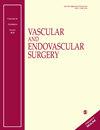Open Surgical Repair in a Patient With Loeys-Dietz Syndrome and Extensive Vascular Compromise: A Case Report and Literature Review
IF 0.7
4区 医学
Q4 PERIPHERAL VASCULAR DISEASE
引用次数: 0
Abstract
Loeys-Dietz syndrome (LDS) has been associated with multiple vascular abnormalities involving the entire arterial tree. However, limited reports regarding compromise in the aortoiliac and femoral bifurcation are available. Further, recommendations for optimal approach, thresholds for diameter at the time of surgery, and surveillance are also limited. We present a case of a 67-year-old male patient with LDS and aneurysmal aortoiliac and enlarging common femoral arteries aneurysms, who underwent open surgical repair. His past surgical history included multiple vascular interventions for lower extremity claudication and bilateral hip replacements. The right hip arthroplasty was previously removed due to infection. From the vascular standpoint, the patient underwent staged endovascular left hypogastric artery embolization and open aorto-bi-profunda bypass with a Rifampin-soaked Dacron graft. At 5-month follow-up, he remains asymptomatic with healed incisions and patent bypasses. This case highlights the challenges in managing peripheral aneurysms in LDS patients, emphasizing the need for tailored treatment strategies. While open repair is preferred, endovascular options may be considered in selected cases. Surveillance remains critical with annual cross-sectional imaging. Surgical planning is intricate due to comorbidities, anatomical complexities, and previous surgical infection. Surveillance of these patients must be strict as multiple vascular and non-vascular complications may arise. Therefore, collaborative decision-making is essential for optimal outcomes in this known high-risk population with connective tissue disorders.一名洛伊-迪茨综合征和大面积血管损伤患者的开放手术修复:病例报告和文献综述
Loeys-Dietz 综合征(LDS)与涉及整个动脉树的多种血管异常有关。然而,有关主动脉髂动脉和股动脉分叉受损的报告却很有限。此外,关于最佳手术方法、手术时直径阈值和监测的建议也很有限。我们介绍了一例 67 岁男性患者的病例,他患有 LDS 和动脉瘤性主动脉髂动脉瘤和股总动脉瘤,并接受了开放手术修复。他的既往手术史包括多次血管介入治疗下肢跛行和双侧髋关节置换术。右侧髋关节置换术曾因感染而被切除。从血管角度来看,患者接受了分阶段的左胃下动脉血管内栓塞术和使用利福平浸泡过的达克龙移植物的开放式主动脉-双股浅动脉搭桥术。随访 5 个月后,患者仍无症状,切口愈合,旁路通畅。这个病例凸显了 LDS 患者外周动脉瘤治疗的挑战,强调了定制治疗策略的必要性。虽然开放性修复是首选,但在选定的病例中也可以考虑血管内治疗方案。每年进行横断面成像监测仍然至关重要。由于合并症、解剖复杂性和既往手术感染等原因,手术规划非常复杂。由于可能出现多种血管和非血管并发症,因此必须对这些患者进行严格监控。因此,对于这种已知的结缔组织疾病高危人群,合作决策对于获得最佳治疗效果至关重要。
本文章由计算机程序翻译,如有差异,请以英文原文为准。
求助全文
约1分钟内获得全文
求助全文
来源期刊

Vascular and Endovascular Surgery
SURGERY-PERIPHERAL VASCULAR DISEASE
CiteScore
1.70
自引率
11.10%
发文量
132
审稿时长
4-8 weeks
期刊介绍:
Vascular and Endovascular Surgery (VES) is a peer-reviewed journal that publishes information to guide vascular specialists in endovascular, surgical, and medical treatment of vascular disease. VES contains original scientific articles on vascular intervention, including new endovascular therapies for peripheral artery, aneurysm, carotid, and venous conditions. This journal is a member of the Committee on Publication Ethics (COPE).
 求助内容:
求助内容: 应助结果提醒方式:
应助结果提醒方式:


